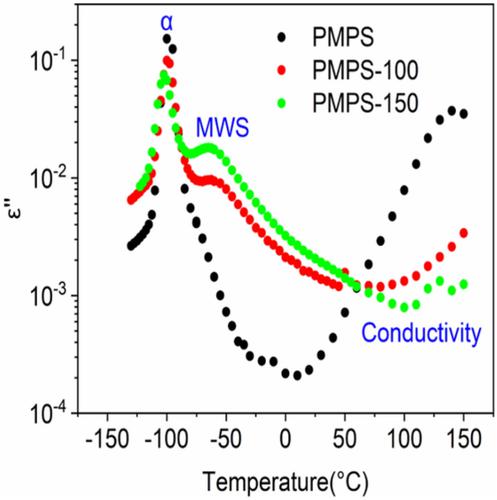当前位置:
X-MOL 学术
›
J. Appl. Polym. Sci.
›
论文详情
Our official English website, www.x-mol.net, welcomes your
feedback! (Note: you will need to create a separate account there.)
Dielectric properties and dielectric relaxation process of polymethylphenylsiloxane/silicon dioxide nanocomposites
Journal of Applied Polymer Science ( IF 2.7 ) Pub Date : 2022-06-02 , DOI: 10.1002/app.52716 Yan Yu 1, 2 , Yan Zhao 1, 2 , Bin Huang 1 , Yanwei Ji 1, 2 , Yunfeng Zhao 1 , Zhijie Zhang 1 , Hua‐Feng Fei 1
Journal of Applied Polymer Science ( IF 2.7 ) Pub Date : 2022-06-02 , DOI: 10.1002/app.52716 Yan Yu 1, 2 , Yan Zhao 1, 2 , Bin Huang 1 , Yanwei Ji 1, 2 , Yunfeng Zhao 1 , Zhijie Zhang 1 , Hua‐Feng Fei 1
Affiliation

|
In recent years, polysiloxane dielectric elastomers (DEs) have attracted extensive attention, but their low dielectric constant and electrical breakdown strength are the main factors that limit their wide application. In this work, we report the effects that a high content of hydrophobic silica has on the dielectric properties and dielectric relaxation behavior of polymethylphenylsiloxane (PMPS). Introducing a high content of hydrophobic silica into PMPS composites increased the dielectric constant of PMPS composites from 3.11 to 3.70 and the breakdown strength of PMPS composites from 35.31 to 42.66 kv/mm. The high content of hydrophobic silica is beneficial for restraining or delaying the occurrence of direct current (DC) conductivity and for effectively reducing the dielectric loss of composites in high temperature and low-frequency regions. The high content of hydrophobic silica also produces interfacial polarization in the composites, and this increases the dielectric constant and dielectric loss in the high frequency and low-temperature regions. The dielectric relaxation behavior of PMPS composites was studied in detail using broadband dielectric spectroscopy (BDS) and thermally stimulated depolarization current (TSDC) to better understand the effect of hydrophobic silica on dielectric properties. This work opens a new way to design and prepare polysiloxane-based materials that have a high dielectric constant, low dielectric loss, and high breakdown strength.
中文翻译:

聚甲基苯基硅氧烷/二氧化硅纳米复合材料的介电性能及介电弛豫过程
近年来,聚硅氧烷介电弹性体(DEs)受到广泛关注,但其低介电常数和电击穿强度是限制其广泛应用的主要因素。在这项工作中,我们报告了高含量的疏水二氧化硅对聚甲基苯基硅氧烷 (PMPS) 的介电性能和介电弛豫行为的影响。在 PMPS 复合材料中引入高含量的疏水二氧化硅可将 PMPS 复合材料的介电常数从 3.11 提高到 3.70,并将 PMPS 复合材料的击穿强度从 35.31 提高到 42.66 kv/mm。高含量的疏水二氧化硅有利于抑制或延缓直流电(DC)电导率的发生,有效降低复合材料在高温和低频区的介电损耗。高含量的疏水二氧化硅也会在复合材料中产生界面极化,这会增加高频和低温区域的介电常数和介电损耗。使用宽带介电光谱 (BDS) 和热刺激去极化电流 (TSDC) 详细研究了 PMPS 复合材料的介电弛豫行为,以更好地了解疏水二氧化硅对介电性能的影响。这项工作为设计和制备具有高介电常数、低介电损耗和高击穿强度的聚硅氧烷基材料开辟了一条新途径。使用宽带介电光谱 (BDS) 和热刺激去极化电流 (TSDC) 详细研究了 PMPS 复合材料的介电弛豫行为,以更好地了解疏水二氧化硅对介电性能的影响。这项工作为设计和制备具有高介电常数、低介电损耗和高击穿强度的聚硅氧烷基材料开辟了一条新途径。使用宽带介电光谱 (BDS) 和热刺激去极化电流 (TSDC) 详细研究了 PMPS 复合材料的介电弛豫行为,以更好地了解疏水二氧化硅对介电性能的影响。这项工作为设计和制备具有高介电常数、低介电损耗和高击穿强度的聚硅氧烷基材料开辟了一条新途径。
更新日期:2022-06-02
中文翻译:

聚甲基苯基硅氧烷/二氧化硅纳米复合材料的介电性能及介电弛豫过程
近年来,聚硅氧烷介电弹性体(DEs)受到广泛关注,但其低介电常数和电击穿强度是限制其广泛应用的主要因素。在这项工作中,我们报告了高含量的疏水二氧化硅对聚甲基苯基硅氧烷 (PMPS) 的介电性能和介电弛豫行为的影响。在 PMPS 复合材料中引入高含量的疏水二氧化硅可将 PMPS 复合材料的介电常数从 3.11 提高到 3.70,并将 PMPS 复合材料的击穿强度从 35.31 提高到 42.66 kv/mm。高含量的疏水二氧化硅有利于抑制或延缓直流电(DC)电导率的发生,有效降低复合材料在高温和低频区的介电损耗。高含量的疏水二氧化硅也会在复合材料中产生界面极化,这会增加高频和低温区域的介电常数和介电损耗。使用宽带介电光谱 (BDS) 和热刺激去极化电流 (TSDC) 详细研究了 PMPS 复合材料的介电弛豫行为,以更好地了解疏水二氧化硅对介电性能的影响。这项工作为设计和制备具有高介电常数、低介电损耗和高击穿强度的聚硅氧烷基材料开辟了一条新途径。使用宽带介电光谱 (BDS) 和热刺激去极化电流 (TSDC) 详细研究了 PMPS 复合材料的介电弛豫行为,以更好地了解疏水二氧化硅对介电性能的影响。这项工作为设计和制备具有高介电常数、低介电损耗和高击穿强度的聚硅氧烷基材料开辟了一条新途径。使用宽带介电光谱 (BDS) 和热刺激去极化电流 (TSDC) 详细研究了 PMPS 复合材料的介电弛豫行为,以更好地了解疏水二氧化硅对介电性能的影响。这项工作为设计和制备具有高介电常数、低介电损耗和高击穿强度的聚硅氧烷基材料开辟了一条新途径。


















































 京公网安备 11010802027423号
京公网安备 11010802027423号